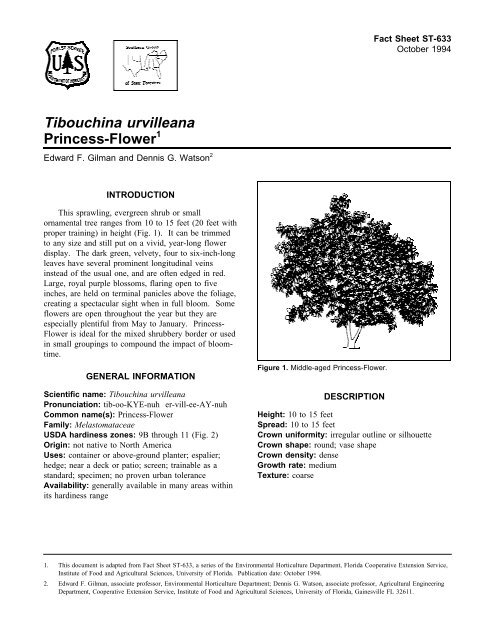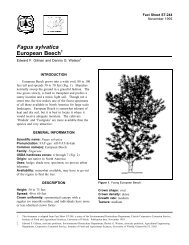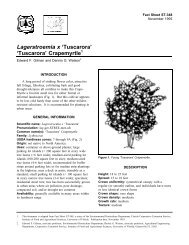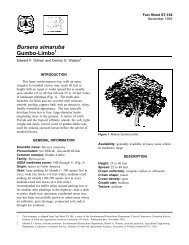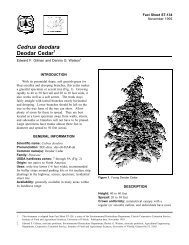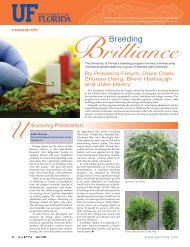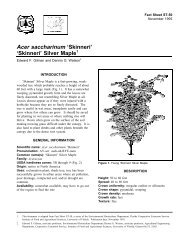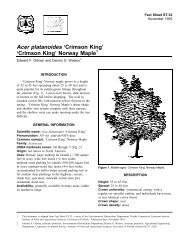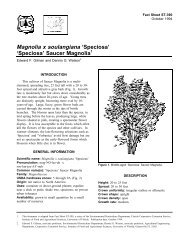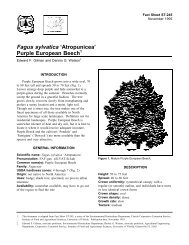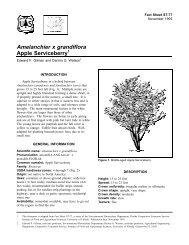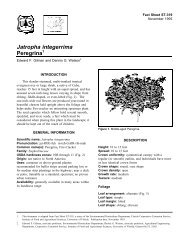Tibouchina urvilleana Princess-Flower - Environmental Horticulture ...
Tibouchina urvilleana Princess-Flower - Environmental Horticulture ...
Tibouchina urvilleana Princess-Flower - Environmental Horticulture ...
Create successful ePaper yourself
Turn your PDF publications into a flip-book with our unique Google optimized e-Paper software.
<strong>Tibouchina</strong> <strong>urvilleana</strong><br />
<strong>Princess</strong>-<strong>Flower</strong> 1<br />
Edward F. Gilman and Dennis G. Watson 2<br />
INTRODUCTION<br />
This sprawling, evergreen shrub or small<br />
ornamental tree ranges from 10 to 15 feet (20 feet with<br />
proper training) in height (Fig. 1). It can be trimmed<br />
to any size and still put on a vivid, year-long flower<br />
display. The dark green, velvety, four to six-inch-long<br />
leaves have several prominent longitudinal veins<br />
instead of the usual one, and are often edged in red.<br />
Large, royal purple blossoms, flaring open to five<br />
inches, are held on terminal panicles above the foliage,<br />
creating a spectacular sight when in full bloom. Some<br />
flowers are open throughout the year but they are<br />
especially plentiful from May to January. <strong>Princess</strong>-<br />
<strong>Flower</strong> is ideal for the mixed shrubbery border or used<br />
in small groupings to compound the impact of bloomtime.<br />
GENERAL INFORMATION<br />
Scientific name: <strong>Tibouchina</strong> <strong>urvilleana</strong><br />
Pronunciation: tib-oo-KYE-nuh er-vill-ee-AY-nuh<br />
Common name(s): <strong>Princess</strong>-<strong>Flower</strong><br />
Family: Melastomataceae<br />
USDA hardiness zones: 9B through 11 (Fig. 2)<br />
Origin: not native to North America<br />
Uses: container or above-ground planter; espalier;<br />
hedge; near a deck or patio; screen; trainable as a<br />
standard; specimen; no proven urban tolerance<br />
Availability: generally available in many areas within<br />
its hardiness range<br />
Figure 1. Middle-aged <strong>Princess</strong>-<strong>Flower</strong>.<br />
DESCRIPTION<br />
Fact Sheet ST-633<br />
October 1994<br />
Height: 10 to 15 feet<br />
Spread: 10 to 15 feet<br />
Crown uniformity: irregular outline or silhouette<br />
Crown shape: round; vase shape<br />
Crown density: dense<br />
Growth rate: medium<br />
Texture: coarse<br />
1. This document is adapted from Fact Sheet ST-633, a series of the <strong>Environmental</strong> <strong>Horticulture</strong> Department, Florida Cooperative Extension Service,<br />
Institute of Food and Agricultural Sciences, University of Florida. Publication date: October 1994.<br />
2. Edward F. Gilman, associate professor, <strong>Environmental</strong> <strong>Horticulture</strong> Department; Dennis G. Watson, associate professor, Agricultural Engineering<br />
Department, Cooperative Extension Service, Institute of Food and Agricultural Sciences, University of Florida, Gainesville FL 32611.
<strong>Tibouchina</strong> <strong>urvilleana</strong> -- <strong>Princess</strong>-<strong>Flower</strong> Page 2<br />
Figure 2. Shaded area represents potential planting range.<br />
Foliage<br />
Leaf arrangement: opposite/subopposite (Fig. 3)<br />
Leaf type: simple<br />
Leaf margin: ciliate; entire<br />
Leaf shape: lanceolate; ovate<br />
Leaf venation: bowed; parallel<br />
Leaf type and persistence: broadleaf evergreen;<br />
evergreen<br />
Leaf blade length: 4 to 8 inches; 2 to 4 inches<br />
Leaf color: green<br />
Fall color: no fall color change<br />
Fall characteristic: not showy<br />
<strong>Flower</strong><br />
<strong>Flower</strong> color: purple<br />
<strong>Flower</strong> characteristics: very showy; year round<br />
flowering<br />
Fruit<br />
Fruit shape: round<br />
Fruit length: < .5 inch<br />
Fruit covering: dry or hard<br />
Fruit color: brown<br />
Fruit characteristics: does not attract wildlife;<br />
inconspicuous and not showy; no significant litter<br />
problem<br />
Trunk and Branches<br />
Trunk/bark/branches: droop as the tree grows, and<br />
will require pruning for vehicular or pedestrian<br />
clearance beneath the canopy; routinely grown with, or<br />
trainable to be grown with, multiple trunks; not<br />
particularly showy; no thorns<br />
Pruning requirement: requires pruning to develop<br />
strong structure<br />
Breakage: susceptible to breakage either at the crotch<br />
due to poor collar formation, or the wood itself is<br />
weak and tends to break<br />
Current year twig color: green<br />
Current year twig thickness: medium<br />
Culture<br />
Light requirement: tree grows in full sun<br />
Soil tolerances: clay; loam; sand; acidic;<br />
well-drained<br />
Drought tolerance: high<br />
Aerosol salt tolerance: none
<strong>Tibouchina</strong> <strong>urvilleana</strong> -- <strong>Princess</strong>-<strong>Flower</strong> Page 3<br />
Figure 3. Foliage of <strong>Princess</strong>-<strong>Flower</strong>.<br />
Other<br />
Roots: surface roots are usually not a problem<br />
Winter interest: no special winter interest<br />
Outstanding tree: not particularly outstanding<br />
Invasive potential: little, if any, potential at this time<br />
Pest resistance: long-term health usually not<br />
affected by pests<br />
USE AND MANAGEMENT<br />
<strong>Princess</strong>-<strong>Flower</strong> requires full sun for best<br />
flowering and will thrive on any well-drained soil<br />
when regularly watered. Its growth habit is somewhat<br />
weedy, requiring training and pruning to develop and<br />
maintain it as a tree. It can be trained as a standard or<br />
espaliered against a west-facing wall receiving at least<br />
five hours of full sun. It can also be trained on a<br />
trellis or arbor as a vine. Pinching new growth helps<br />
increase branching and will enhance the flower<br />
display.<br />
<strong>Tibouchina</strong> granulosa grows larger (15 to 20 feet<br />
tall and wide) and is easier to train into a tree.<br />
Propagation is by cuttings.<br />
Pests<br />
Some of its pests are scales and nematodes.<br />
Diseases<br />
Mushroom root rot in soil which is kept too wet.


